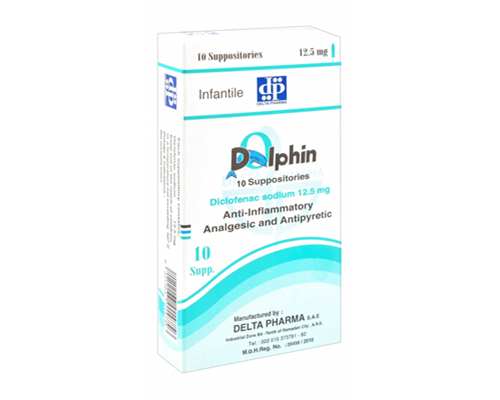Description
Trade name:
Voltaren suppositories
Compound:
Each rectal suppository contains:
Diclofenac sodium 100 mg
Auxiliary components:
Solid fat up to 2 g.
Properties:
Non-steroidal anti-inflammatory drug (NSAID), derivative of phenylacetic acid. Has pronounced anti-inflammatory, analgesic and moderate antipyretic effects.
Indications:
Inflammatory and degenerative diseases of the musculoskeletal system, including rheumatoid, juvenile, chronic arthritis; ankylosing spondylitis and other spondyloarthropathies; osteoarthrosis; gouty arthritis; bursitis, tendovaginitis; pain syndrome from the spine (lumbago, sciatica, ossalgia, neuralgia, myalgia, arthralgia, radiculitis); post-traumatic postoperative pain syndrome accompanied by inflammation (for example, in dentistry and orthopedics); algomenorrhea; inflammatory processes in the pelvis (including adnexitis); infectious and inflammatory diseases of the ENT organs with severe pain syndrome (as part of complex therapy): pharyngitis, tonsillitis, otitis.
Isolated fever is not an indication for the use of the drug.
The drug is intended for symptomatic therapy, reduction of pain and inflammation at the time of use, and does not affect the progression of the disease.
Method of administration and dosage:
The dose is selected individually; it is recommended to use the drug in the minimum effective dose with the shortest possible treatment period.
For adults, the recommended initial dose is 100-150 mg/day. In relatively mild cases of the disease, as well as for long-term therapy, 75-100 mg/day is sufficient.
When used in total in the form of suppositories, the daily dose should not exceed 150 mg.
Contraindications:
Hypersensitivity to diclofenac and excipients of the drug used; “aspirin triad” (attacks of bronchial asthma, urticaria and acute rhinitis when taking acetylsalicylic acid or other NSAIDs); erosive and ulcerative lesions of the gastrointestinal tract in the acute phase; proctitis; third trimester of pregnancy.
Precautions:
Use with caution in the following conditions:
Suspected gastrointestinal disease; history of gastrointestinal bleeding and ulcer perforation (especially in elderly patients), Helicobacter pylori infections, ulcerative colitis, Crohn’s disease, impaired function; mild to moderate liver dysfunction, hepatic porphyria (diclofenac may provoke porphyria attacks); in patients with bronchial asthma, seasonal allergic rhinitis, swelling of the nasal mucosa (including nasal polyps), COPD, chronic infectious respiratory diseases (especially associated with allergic rhinitis-like symptoms); cardiovascular diseases (including coronary heart disease, cerebrovascular diseases, compensated heart failure, peripheral vascular diseases); impaired renal function, including chronic renal failure (CC 30-60 ml / min); dyslipidemia/hyperlipidemia; diabetes mellitus; arterial hypertension; significant decrease in circulating blood volume of any etiology (for example, before and after major surgical interventions); hemostatic disorder; risk of thrombosis (including myocardial infarction and stroke); elderly patients, especially weakened or with low body weight (diclofenac should be used in the minimum effective dose); in patients receiving drugs that increase the risk of gastrointestinal bleeding, including systemic GCS (including prednisolone), anticoagulants (including warfarin), antiplatelet agents (including clopidogrel, acetylsalicylic acid), selective serotonin reuptake inhibitors (including citalopram, fluoxetine, paroxetine, sertraline); concomitant treatment with diuretics or other drugs that can impair renal function; in the treatment of smoking patients or patients who abuse alcohol; when administered intramuscularly to patients with bronchial asthma due to the risk of exacerbation of the disease (since sodium bisulfite, which is contained in some injection dosage forms, can cause severe hypersensitivity reactions).
Side effects:
From the digestive system: often – abdominal pain, nausea, vomiting, diarrhea, dyspepsia, flatulence, decreased appetite, anorexia, increased activity of aminotransferases in the blood serum; rarely – gastritis, gastrointestinal bleeding, vomiting of blood, melena, diarrhea with an admixture of blood, ulcers of the stomach and intestines (with or without bleeding or perforation), hepatitis, jaundice, liver dysfunction; very rarely – stomatitis, glossitis, damage to the esophagus, the occurrence of diaphragm-like strictures in the intestine, colitis (nonspecific hemorrhagic colitis, exacerbation of ulcerative colitis or Crohn’s disease), constipation, pancreatitis, fulminant hepatitis, liver necrosis, liver failure.
From the nervous system: often – headache, dizziness; rarely – drowsiness; very rarely – sensory disturbances, including paresthesia, memory disorders, tremor, convulsions, anxiety, acute cerebrovascular accident, aseptic meningitis; very rarely – disorientation, depression, insomnia, nightmares, irritability, mental disorders.
From the sensory organs: often – vertigo; very rarely – visual impairment (blurred vision), diplopia, hearing impairment, tinnitus, dysgeusia.
Dermatological reactions: often – skin rash; rarely – urticaria; very rarely – bullous rash, eczema, erythema, erythema multiforme, Stevens-Johnson syndrome, Lyell’s syndrome (toxic epidermal necrolysis), exfoliative dermatitis, itching, hair loss, photosensitivity reactions; purpura, Henoch-Schonlein purpura.
From the genitourinary system: very rare – acute renal failure, hematuria, proteinuria, tubulointerstitial nephritis, nephrotic syndrome, papillary necrosis.
From the hematopoietic system: very rare – thrombocytopenia, leukopenia, hemolytic anemia, aplastic anemia, agranulocytosis.
Allergic reactions: rare – hypersensitivity, anaphylactic/anaphylactoid reactions, including decreased blood pressure and shock; very rare – angioedema (including facial edema).
From the cardiovascular system: very rare – palpitations, chest pain, increased blood pressure, vasculitis, heart failure, myocardial infarction. There is data on a slight increase in the risk of developing cardiovascular thrombotic complications (eg, myocardial infarction), especially with long-term use of diclofenac in high doses (daily dose over 150 mg).
From the respiratory system: rarely – asthma (including dyspnea); very rarely – pneumonitis.
General reactions: rarely – swelling.
Storage method:
Store at temperatures not exceeding 30 degrees.









